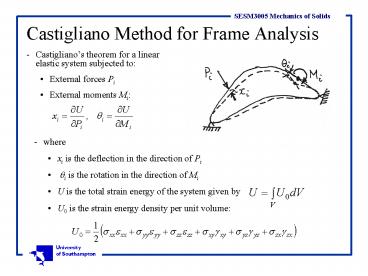Castigliano Method for Frame Analysis - PowerPoint PPT Presentation
1 / 19
Title:
Castigliano Method for Frame Analysis
Description:
Statically indeterminate systems. If the number of unknown ... Statically indeterminate structure with one redundant internal unknown: axial force NAD = NDC ... – PowerPoint PPT presentation
Number of Views:1164
Avg rating:3.0/5.0
Title: Castigliano Method for Frame Analysis
1
Castigliano Method for Frame Analysis
- Castiglianos theorem for a linear elastic system
subjected to - External forces Pi
- External moments Mi
- where
- xi is the deflection in the direction of Pi
- qi is the rotation in the direction of Mi
- U is the total strain energy of the system given
by - U0 is the strain energy density per unit volume
2
Castigliano Method for Frame Analysis
- Method applied to linear elastic systems
consisting of slender, straight or curvilinear
members (rods, beam, shafts etc) with uniform
cross-section. - General member configuration in 3D
- Internal forces/moments
- Axial force N(s)
- Bending moment M(s)
- Shear force V(s)
- Torque T(s)
- Stresses
- N and M generate axial stress s
- V and T generate shear stress t
3
Castigliano Method for Frame Analysis
- Strain energy density
- Total strain energy
- Contributions to the strain energy U
- Axial force N
4
Castigliano Method for Frame Analysis
- Contributions of M, V, and T to the strain energy
U obtained by a similar, albeit more complicated
process
- Final expressions
- Axial force N
- Bending moment M
- Shear force V
- Torque T
5
Example 5.7 Shaft-beam mechanism
- Beams CD, FH rectangular section
- Shaft AB circular section
- Determine the rotation of end section at B.
- Castigliano equation (neglecting shear force
contributions to U)
- Reactions must be determined SFy 0 ? RC RH
0 - SMH 0 ? 1.0?RC - T0 0 ? RC - RH T0
6
Example 5.7 Shaft-beam mechanism
- Expressions for V, M, T Sections - Free body
diagrams (FBD) - Beam CD
- V RC T0
- M xRC xT0 ?
- T 0
- Shaft AB
- V M 0
- T T0 ?
7
Example 5.10
- Problem data
- d 20 mm
- R 200 mm
- P Q 150 N
- E 200 GPa
- G 77.5 GPa
- Determine deflection at C
- Sections FBDs to determine expressions for N,
V, M
8
Example 5.10
- Part BC 0 ? f ? p/2
- N Pcosf ?N/ ?P cosf
- V Psinf ?V/ ?P sinf
- M PR(1-cosf) ?M/ ?P R(1-cosf)
- Part AB 0 ? q ? p/2
- N - (PQ)sinq , ?N/ ?P - sinq
- V (PQ)cosq , ?V/ ?P cosq
- M PR(1sinq) QRsinq, ?M/ ?P R(1sinq)
9
Example 5.10
- Deflection at C (considering only contributions
from M)
- Determine, evaluate and compare contributions
from N, V and M. (take shear constant k 10/9)
10
Deflection/rotation in any direction
- (not necessarily in the direction of applied
force/moment) - A fictitious force/moment X is assumed acting at
a point P in any direction q. Then the
displacement/rotation of/about that point in the
chosen direction is given according to
Castigliano by
The bending moment in a member can be considered
as the combination of M(z) due to actual
applied forces m(z) due to a fictitious unit
force acting at P in the direction of q
11
Deflection/rotation in any direction
- The principle of superposition applies to linear
elastic systems. Therefore, the total bending
moment - M(X, z) M(z) Xm(z)
- Hence
- M(X 0, z) M(z)
- ?M/?X m(z)
- General expression for the deflection/rotation
12
Example 5.13
- Determine deflection of free end B
- Sections and FBDs
- Part OA
- Actual forces
- M Rsinq ?P
- T R(1 cosq ) ?P
- Fictitious unit force
- m Rcosq ?1
- t R(1 sinq ) ?1
13
Example 5.13
- Part AB
- Actual forces Fictitious unit force
- M 0 m Rsinf ?1
- T 0 t R(1 cosf ) ?1
- Substituting into the Castigliano equation
14
Statically indeterminate systems
- If the number of unknown forces/moments is
- gt 6 in 3D
- gt 3 in 2D
- the equations of equilibrium are not sufficient
for a complete analysis of the frame, i.e. for
finding stresses and deflections. - If the redundant unknowns are X1, X2, , Xn,
Castiglanos theorem provides n additional
equations
- The validity of the above is obvious when Xi is a
reaction but it can also be proved in the case of
internal redundant forces/moments
15
Example 5.16
- 2D frame, 5 reactions, therefore two redundant
reactions - Reactions H, Q at C are selected for applying
Castigliano equations
- Axial, shear force contributions to U are
neglected - Sections and FBDs
16
Example 5.16
- (i) Part BC
- 0 ? q ? p
- M -R(1-cosq)H (Rsinq)Q
- ?M/ ?H -R(1-cosq), ?M/ ?Q Rsinq
- (ii) Part AB
- 0 ? z ? 2R
- M z(P-Q) - 2RH
- ?M/ ?H -2R, ?M/ ?Q -z
17
Example 5.16
- Castigliano equations
Integrating (3p/2 8)H 2Q 4P 2H (p/2
8/3)Q 8P/3 Solution Q 0.5193P H 0.2329P
Vertical deflection at P since
18
Example 5.17 Inverted king post
- Determine max P with SF 2.0
- Statically indeterminate structure with one
redundant internal unknown axial force NAD NDC
- Castigliano is applied neglecting N, V
contributions in beam AC, considering only N
contributions in AD, DC and DB - Sections and FBDs, accounting for symmetry
19
Example 5.17 Inverted king post
- Force equilibrium at joint D
- NBD 2NAD sina
- where
- tana 0.5/2 0.25
- Bending moment in AB
- M z(P/2 - NAD sina)
- Hence
- ?M/ ?NAD - (z sina)

